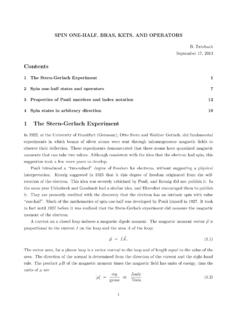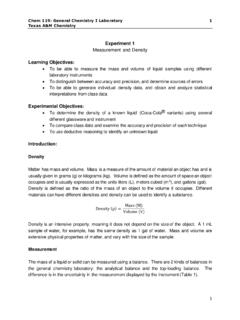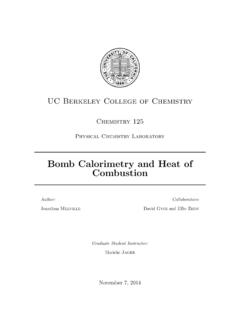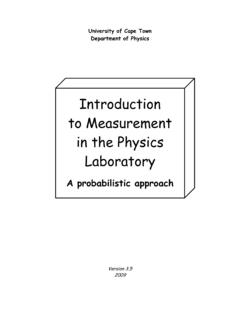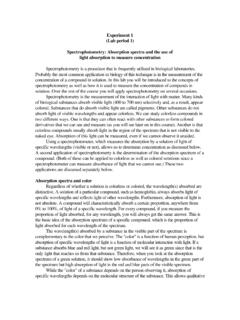Transcription of Propagation of Uncertainty through Mathematical Operations
1 M. Palmer1 Propagation of Uncertainty through Mathematical OperationsSince the quantity of interest in an experiment is rarely obtained by measuring that quantitydirectly, we must understand how error propagates when Mathematical Operations are performedon measured quantities. Suppose we have a simple experiment where we want to measurevelocity, V, by measuring distance, d, and time, t. We take measurements and come up withmeasured quantities d d and t t. We can easily estimate V by dividing d by t, but we alsoneed to know how to find V. Below we investigate how error propagates when mathematicaloperations are performed on two quantities x and y that comprise the desired quantity and SubtractionIf we are trying to find the Uncertainty , q, associated with q = x + y, we can look at what thehighest and lowest probable values would be.
2 The highest value would be obtained by addingthe best estimates for x and y to the total Uncertainty for both values. Similarly, the lowestprobable value would be obtained by adding the best estimates for x and y and subtracting bothassociated uncertainties:(highest probable value of q) = xbest + ybest + ( x + y)(2)(lowest probable value of q) = xbest + ybest _ ( x + y)(3)Since qbest = xbest + ybest, it is easy to see q is equal to x + y and q can be expressed as:qbest = xbest + ybest ( x + y)(4)Similarly, for subtraction, we can write that:qbest = xbest _ ybest ( x + y)(5)A similar analysis as shown above can be applied to any number of quantities that are added orsubtracted, and we can state a general rule:For q = x + .. + z (u + .. + w), q = x + ..+ z ( u + .. + w)Or more simply put, when adding or subtracting quantities, their uncertainties of a ProductWe can perform a similar analysis as above for multiplication, but first we must define fractionaluncertainty of a quantity:Rule 1: Uncertainty in Sums and DifferencesM.
3 Palmer2(fractional Uncertainty in x) = bestxx .(6)The fractional Uncertainty (or, as it is also known, percentage Uncertainty ) is a normalized,dimensionless way of presenting Uncertainty , which is necessary when multiplying or measurement and its fractional Uncertainty can be expressed as:(value of x) = +bestbestxxx 1.(7)For simplicity, hereafter the subscript best will be omitted in the denominator of the fractionaluncertainty, but it is assumed. For q = xy, we have measured values for x and y of the form:(measured x) = +xxxbest 1(8)(measured y) = +yyybest 1(9)Once again we look at the largest and smallest probable values of q:(largest probable value of q) = + +yyxxyxbestbest 11(10)(smallest probable value of q) = yyxxyxbestbest 11(11)We expand (10) to get:(largest probable value of q) = +++yyxxyyxxyxbestbest 1(12)We now must make the assumption that the fractional uncertainties are small (that is, they areless than 1).
4 This is a reasonable assumption since most well-designed experiments will havefractional uncertainties that are or less. If we can say that the fractional uncertainties are lessthan one, then their product will be much less than one and their contribution to the uncertaintynegligible. From this argument, we neglect the last term in (12) and simplify the equation to:(largest probable value of q) = ++yyxxyxbestbest 1(13)M. Palmer3 Similarly, we simplify the equation for the lowest probable value to:(smallest probable value of q) = + yyxxyxbestbest 1(14)This gives a probable range of values for q of:q = + yyxxyxbestbest 1(15)The equation for q is:(value of q) = +qqqbest 1(16)and since qbest = xbestybest, we conclude from (15) and (16) that:yyxxqq + (17)Therefore, to find the Uncertainty of two multiplied quantities, we add the in a QuotientTo estimate the Uncertainty associated with the quotient q=x/y, we once again look at the largestvalue of q we could expect:(largest value of q) = yyxxyxbestbest +11(18)We use a little bit of Mathematical manipulation to simplify (18).
5 The term on the right has theform:ba +11, where a and b are less than 1(19)The binomial theorem allows us to express the denominator term as an infinite series:..1112+++= bbb(20)M. Palmer4 Since b is assumed less than 1, b2 and all of the higher order terms will all be <<1. These can beneglected and we can say that:bb+ 111.(21)Then, (19) becomes()()abbababa+++=++ +11111 Once again we eliminate ab because it is the product of two small numbers. We substitute thefractional uncertainties for a and b and simplify (18) to:(largest value of q) = ++yyxxyxbestbest 1(22)A similar procedure applied to the equation for the smallest value shows that:(smallest value of q) = + yyxxyxbestbest 1(23)Knowing that qbest = xbest / ybest, we find once again that:yyxxqq + Now we extend the separate results for multiplication and division to apply to any number ofquantities that are multiplied or divided:Quantities are measured with small uncertainties andwuzxq =.
6 Then the fractional Uncertainty in the computed value of q is:wwuuzzxxqq +++++ ..In summary, when any number of quantities are multiplied or divided, their fractionaluncertainties 2: Uncertainty in Products and QuotientsM. Palmer5 Summing errors in quadratureThe two rules we have defined so far state that for addition or subtraction, we sum theuncertainties, and for multiplication and division, we sum the fractional uncertainties. However,if the original uncertainties associated with the measured quantities are independent and random,these rules will produce values of Uncertainty that are unnecessarily large. Thus we consideranother method for computing propagated previously stated that the highest value we would expect for the quantity q = x + y is xbest +ybest + ( x + y).
7 For this to be the actual value of q, though, we would have had tounderestimate both x and y by their full amounts x and y. If x and y are independent errors andrandom in nature, we have a 50% chance that an underestimate of x is accompanied by anoverestimate of y. The probability we would underestimate both by the full amount is very smalland an Uncertainty of q = x + y would be too detailed justification, we present an alternative way of calculating Uncertainty , assumingerrors in measurement are governed by the normal (or Gaussian) distribution and that measuredquantities are independent of each other. This method, called adding in quadrature, provides thefollowing rules for computing Uncertainty in x,..,w are measured with independent and random uncertainties x,.., w, and are used to compute q = x +.
8 + z (u + ..+ w), then theuncertainty in q is the quadratic sum:()() ()2222)(..wuzxq +++++=If x,..,w are measured with independent and random uncertainties x,.., w, and are used to compute wuzxq =.. then the Uncertainty inq is the quadratic ++ + ++ =wwuuzzxxqq Rule 3: Uncertainty in Sums and Differences for Random and IndependentUncertaintiesRule 4: Uncertainty in Products and Quotients for Random and IndependentUncertaintiesM. Palmer6 Notice that the procedure of adding in quadrature will always produce values smaller than usingordinary addition to sum uncertainties. Indeed, rules 1 and 2 are upper bounds for theuncertainty of a measured quantity. The Uncertainty of q will be no larger than the valuesproduced by rules 1 and 2. Rules 3 and 4 are a way Uncertainty can be reduced under important consequence of using rules 3 and 4 is that small uncertainties are madesmaller when they are squared, making their contribution to the overall Uncertainty , for example, we are trying to measure the density of a gas using the ideal gas law: =P/RT, where is the density of the gas, P is the pressure, R is the gas constant, and T is thetemperature.
9 R is a constant known with much precision, so we do not even consider itscontribution to Uncertainty . For temperature, we re using a high-precision thermometer and weestimate that T/|T| is 2%. Our pressure gauge, though, doesn t have very fine markings, and weestimate P/|P| is 10%. We then compute:() ( ) += + =TTPP (24)and find /| | = or 10%. The small error associated with temperature made no contributionto the overall error. This tells us that the best way to reduce the overall Uncertainty in anexperiment is refine the measurement procedures for the quantities with the highest note of caution on assuming random and independent uncertainties: If we use one instrumentto measure multiple quantities, we cannot be sure that the errors in the quantities areindependent.
10 If instrument calibration is the cause of the error, the errors are not independentand the total error should not be computed by summing in Formula for Error PropagationVery often, the quantity being investigated in an experiment cannot be computed through thesimple Mathematical Operations discussed above. In many experiments, we must understandhow error propagates through more complex functions, such as those that contain exponents,logarithms, and trigonometric us examine a quantity q that is some function of a variable x (such as q=sinx or q=x3). Wealso assume, as usual, that our measurement of x has the form xbest x. Then our best estimateof q is qbest=q(xbest). As we have done before, we estimate the largest probable value of q. Inthis case, the maximum value of q is qmax= q(xbest x). To determine what this value is, wemust evaluate the function q at xbest x.










